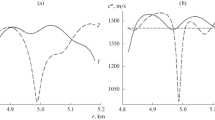Abstract
Relations for calculating the amplitude and phase characteristics of sound pressure and orthogonal projections of the vibration velocity vector and phase gradient in shallow water have been derived. Dependences of the effective phase velocity of equivalent plane wave, orthogonal projections of the gradient of sound pressure phase, and projections of the vibration velocity vector on the transmitter (or receiver) depth are calculated for different frequencies and location depths of receivers (and transmitters). It is found that the horizontal projections of the vibration velocity vector and phase gradient satisfy the reciprocity principle whereas their vertical projections do not obey this principle. Therefore, the characteristics of the vertical components must be studied independently with variation in their transmission or reception depth. It is shown that, for low frequencies and variable transmitter or receiver depth, the effective phase velocities in interference maxima exceed generally the speed of sound in water by 5-15% or even more. Some recommendations on the use of sound field characteristics in the regions of maximum sound pressure for solving problems of direction finding and signal detection are formulated. The behavior of the characteristics of arrival angles of equivalent plane wave with variation in the transmission or reception depth are investigated.
Similar content being viewed by others
References
A.B. Baggeroer and W.A. Kuperman, “Matched Field Processing in Ocean Acoustics,” in Acoustic Signal Processing for Ocean Exploration. Ed. by J.M.F. Moura and I.M.G. Lourtie (Kluwer Academic Publishers, Dordrecht, Boston, London, 1992), pp. 79–114.
B.G. Katsnel’son and V.G. Petnikov, Shallow Water Acoustics (Nauka, Moscow, 1997) [in Russian].
G.A. Grachev and G.N. Kuznetsov, “On the Average Rate for Phase Variation in the Acoustic Field along the Flat Waveguide,” Sov. Phys.-Acoust. 31(2), 266 (1985) [in Russian].
G.N. Kuznetsov and O.V. Lebedev, “The Possibility of Using the Equivalent Plane Wave Model to Increase the Efficiency of Taking Bearings of Low-Frequency Signals in Shallow Water,” Acoust. Phys. 58(5), 575 (2012).
G.N. Kuznetsov and O.V. Lebedev, “Bearing Determination of Low-Frequency Sources in aWave Guide by Sonar Systems with Towed or Hull Antennas,” Gidroakustika. 17(1) (2013) [in Russian].
V.A. Shchurov, Vector Acoustics of the Ocean (Dal’nauka, Vladivostok, 2003) [in Russian].
V.A. Gordienko, Vector-Phase Methods in Acoustics (Fizmatlit, Moscow, 2007) [in Russian].
L.M. Brekhovskikh, Waves in Layered Media (Academic Press, N.Y., 1980).
V.A. Zhuravlev, I.K. Kobozev, and Yu.A. Kravtsov, “Detecting Dislocations by Measuring the Energy Flux of an Acoustic Field,” JETP. 77(5), 808 (1993).
A.N. Stepanov, Multipole Model of Hydroacoustic Sources (Izd-vo Samar. Univ., Samara, 2000) [in Russian].
D.E. Weston, “AMoire Fringe Analog of Sound Propagation in Shallow Water,” J. Acoust. Soc. Am. 65(2), 647 (1960).
E. Skuchik, The Foundations of Acoustics (Springer, N.Y., 1971).
M.Ya. Isakovich, General Acoustics (Nauka, Moscow, 1973) [in Russian].
V.A. Eliseevnin and Yu.I. Tuzhilkin, “Acoustic Power Flux in a Waveguide,” Acoust. Phys. 47(6), 688 (2001).
V.M. Kuz’kin, A.V. Ogurtsov, and V.G. Petnikov, “The Effect of Hydrodynamic Variability on Frequency Shifts of the Interference Pattern of a Sound Field in a Shallow Sea,” Acoust. Phys. 44(1), 77 (1998).
A.I. Belov and G.N. Kuznetsov, “Characteristics of Normal Waves Exited by Vertical Arrays in Shallow Sea,” Phys.Wave Phenom. 14(3), 66 (2006).
G.N. Kuznetsov and A.N. Stepanov, “The Field of an Equivalent Multipole Composite Radiator in a Waveguid,” Acoust. Phys. 53(3), 326 (2007).
Author information
Authors and Affiliations
Corresponding author
About this article
Cite this article
Kuznetsov, G.N., Stepanov, A.N. Interference and phase structure of the low-frequency vector-scalar field in shallow water for variable reception or transmission depths. Phys. Wave Phen. 23, 279–291 (2015). https://doi.org/10.3103/S1541308X15040068
Received:
Published:
Issue Date:
DOI: https://doi.org/10.3103/S1541308X15040068




